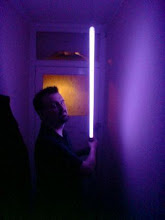In the meantime, I thought it would be cool to see what David himself had to say about the sources of inspiration and influence that led to the series. Luckily for me, David thought that would be pretty cool as well. Here's what he had to say for himself...

Thanks to Graeme for the space, and congratulations on the arrival of his new addition to the family! Over here at AutumnRain HQ, I'm working on unveiling my own 'offspring', THE MACHINERY OF LIGHT, which completes the trilogy that began with THE MIRRORED HEAVENS and THE BURNING SKIES. And I thought it might be interesting to talk about the Autumn Rain trilogy as a hybrid work that combines several elements, drawing on my favorite influences, and whipping them up into one big stew:
Cyberpunk: I think anyone who writes near-future SF is writing cyberpunk by definition. And yet old-guard cyberpunk's focus on rival corporations battling each other in an age of weakened/vanishing nation-states never quite rang true to me. .. and makes even less to me now that we seem to be entering upon a new age of cyberwarfare (witness Russia's shutdown of the Georgian nets in 2008). Rather than being mercenary street samurai, my hackers are all intel agents working to Keep America Safe. Of course, that brings us to ..
Espionage: I grew up on Cold War thrillers – Deighton, LeCarre, etc., which had a marked influence on the direction I took with the Autumn Rain trilogy. I used to warm up for writing sessions by re-reading pages from LeCarre's Tinker, Tailor, Soldier, Spy, so when my agent sold the trilogy to Bantam as "LeCarre on sci-fi crack", it couldn't have made me happier.(I'm still working on finding a good dealer for sci-fi crack, though.) But of course this is espionage in the 22nd century, so the enemy could be inside your head already. And those memories of yours? – let's just say you'd be wise not to trust them completely…

Military SF: I find the Manichean world painted by a lot of military SF to be somewhat tedious, in that real life tends to be more complex than Forces of Good battling the Evil Hordes. But at the same time, I love a great battle sequence, and was really looking to raise the bar here, with supersonic maglev trains beneath the Atlantic, powered armor slugouts at the lunar south pole, O'Neill cylinders with asteroids stapled to their poles and as much cool weaponry as possible. Which leads me to:
Space warfare: Not exactly a separate category—and frankly, not even fiction – but this is where the books had their genesis, when I became fascinated by how the center of gravity of modern warfare is inexorably moving into space. The orbits are already militarized—every time an American GI uses GPS, that's drawing on space's militarization – but the question remains what it's going to look like when nations (and insurgents) start putting weapons up there. That this is likely to occur in tandem with the maturity of directed energy weapons (e.g., lasers, particle beams, etc.) is almost certain to put international tensions on an absolute hair-trigger. My Earth-Moon system is an armed camp, divided between the two superpowers. . . .and last year, I also released an essay on my website that details the likely evolution of warfare's next stage (and presented it at the National Academy of Sciences and the Library of Congress last year, which was a lot of fun).
Video games: A totally separate medium, sure – but it's where I got my start. A quirk of fate put me in the cockpit of Relic Entertainment's Homeworld franchise back in the day; I have story concept/co-writer credits on the first game, and was a contributing writer on the Homeworld 2 sequel. That experience taught me all about the importance of spectacle .. . . and it also made me contemplate an approach to characterization and story where one holds back key elements in order to draw the reader further into the narative – to make the reader function in some ways as a character – as they do in video games -- in that they're the only one who has the vantage point necessary to see across the strands of interlocking conspiracy woven through the books….
But video games also left me eager to render some of the books' content in a visual medium. Not only does my website feature a lot of cool art relating to the trilogy, but I'm also pleased to unveil this kick-ass trailer created by one of the visual-sound maestros behind Homeworld, my friend Paul Ruskay. Roll 'em for MACHINERY OF LIGHT. . .
And thanks again Graeme!
No worries :o) You can check out David's website over Here and like I said, I'll let you know what I thought of 'The Machinery of Light' as soon as I've got a spare second to read it...

1 comment:
Ahhh I had trouble reading his first book, I ended up quiting halfway through. But as with your interview of Aaron Dembski-Bowden this has convinced me to give the guy a another try.
Post a Comment